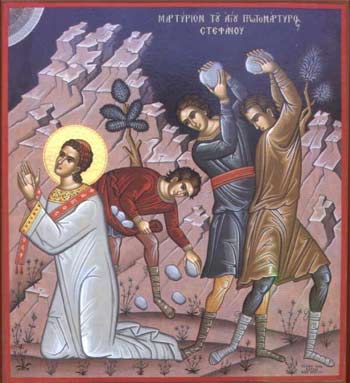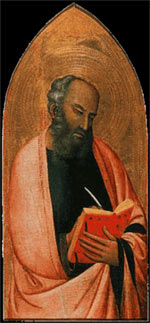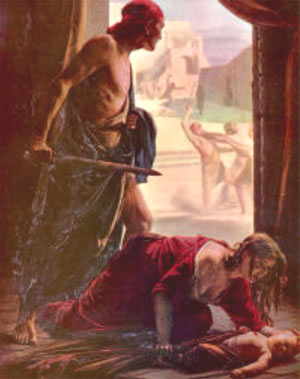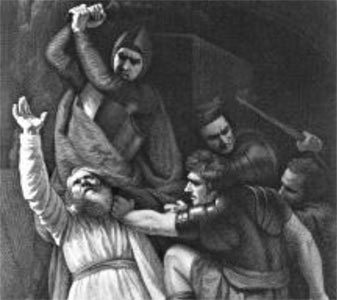
The Nature of Christian Martyrdom
The Christmas Feasts of the Martyrs December 26-28:
St. Stephen, St. John, the Holy Innocents
A martyr, a saint, is always made by the design of God,
for His love of men, to warn them and to lead them,
to bring them back to His ways.
-St. Thomas Becket, speaking Christmas morning,
four days before he was martyred; his feast day is December 29.
The placement of the three feast days immediately following the Nativity (Christmas) has been a subject of some discussion over the centuries. Specific explanations for the placement of the feasts were not set down in writing at the time they were established, but good insights can be ascertained from commentaries made soon after as well as from descriptions that have persisted through the centuries.
In gaining an appreciation for this subject, it must first recognized that the celebration of Christmas began around 375 A.D. The Catholic Encyclopedia traces the earliest records and notes that:
In Antioch, on the feast of St. Philogonius, John Chrysostom [347-407 A.D.] preached an important sermon. The year was almost certainly 386…..In view of a reaction to certain Jewish rites and feasts, Chrysostom tries to unite Antioch in celebrating Christ's birth on 25 December, part of the community having already kept it on that day for at least ten years.
The feast of St. Stephen was placed on December 26 almost immediately after the beginnings of the Christmas celebration. We have a homily-one of two on the subject of St. Stephen-by St. Gregory of Nyssa (a town located about 150 miles to the north of Antioch) on December 26 in 386 A.D., in which he opens with these words (referring here to St. Stephen as the "imitator of the Lord"):
How lovely is the inspiration exhibited by those who are good, and how sweet is the joy which they disclose! See, we acquire a feast from a feast and grace from grace. Yesterday the Lord of the universe welcomed us whereas today it is the imitator of the Lord. How are they related to each other? One assumed human nature on our behalf while the other shed it for his Lord. One accepted the cave of this life for us, and the other left it for him. One was wrapped in swaddling clothes for us, and the other was stoned for him. One destroyed death, and the other scorned it.
St. Stephen was the first of Christ's followers to be martyred for defending his faith. One can say that his death was an immediate consequence of the Son of God appearing on earth. On December 25 we recognize the coming of Jesus to life, on December 26 we celebrate his "imitator" coming to death and sainthood. The manner of Stephen's death, a violent one by those, including Saul, who opposed the new faith, was determined by the arrival of Jesus, so the two events were temporally linked by the fathers of the Church. At this time in Church history (386 A.D.) many of the saints were revered specifically because they had died defending the faith. The last of the great Roman persecutions had ceased (313 A.D.) just a few decades prior to the founding of this feast day.

The Apostleship of Prayer, founded in France (1844), presented this explanation in honor of St. Stephen on his feast day:
Yesterday we celebrated the birth in time of our eternal King. Today we celebrate the triumphant suffering of His soldier. The love that brought Christ from heaven to earth raised Stephen from earth to heaven; shown first in the King, it later shone forth in His soldier.

St. John's feast day was established soon afterward and as a direct reflection of celebrating St. Stephen's feast the day after Christmas. St. John was not martyred, and died at an old age after finishing the Book of Revelation (Apocalypse), but he gave his life to the faith in his daily work. Such complete and pure dedication became known as a type of Christian martyrdom. This way of thinking of martyrdom--through giving one's life in daily work for the Church--is well expressed in a letter by St. Jerome from 404 A.D. The letter was written to console Eustochium for the loss of her mother who had recently died. Eustochium and her mother, Paula (both of them recognized as saints), had managed monasteries that Jerome established. He notes in the letter:
Be not fearful, Eustochium: you are endowed with a splendid heritage. The Lord is your portion; and, to increase your joy, your mother has now after a long martyrdom won her crown. It is not only the shedding of blood that is accounted a confession: the spotless service of a devout mind is itself a daily martyrdom. Both alike are crowned; with roses and violets in the one case, with lilies in the other. Thus in the Song of Songs it is written: "my beloved is white and ruddy;" for, whether the victory be won in peace or in war, God gives the same guerdon to those who win it.
He refers to two kinds of martyrdom gaining for the person a "crown:" in one case, signified by roses and violets, the colors of being bloodied and bruised in the martyrdom of death; in the other case, represented by lilies, white with purity of devotion. He then brings forth the image of the bridegroom described in the Song of Songs (Solomon 5:10) "My beloved is white and ruddy." For Christians, Jesus is the bridegroom, the beloved, who is described in this famous song as white and ruddy (red): pure in being and in deeds, martyred by those who do not understand. One commentator on this song, Don Fortner, observed this meaning behind its words:
It seems to me that these words call attention to the two primary characteristics of our Lord's Person. Solomon had often seen the snow-white lambs, those emblems of purity, brought to the temple to be offered in sacrifice to the Lord. So he compares Christ to the white lamb of sacrifice. "My Beloved is white." He had also seen the priest slit the lamb's throat, and then seen the ruby red blood of the lamb poured out in sacrifice to God. So he puts the two together and says, "My Beloved is white and ruddy." The white represents his immaculate purity. The red represents his sacrificial blood.
Putting together the feasts of the Nativity with those of the martyrs both white (St. John) and ruddy (St. Stephen) seems to fit with the notion presented by St. Jerome of two kinds of martyrdom, and with their connection to Jesus coming into the world. The line in the Song of Solomon describing the bridegroom apparently resonated with the theologians of that time. The image of the red and white associated with Jesus appears again in the vision of St. Faustine, where rays of red and white light emanate from the heart of Jesus. The symbolism is retained in the Mass, with the mixing of the red and white-wine (blood) and water-representing the blood and wine spurting from the wound in the side of Jesus when he was pierced on the Cross.
This is not the complete story. The Song presents a third attribute of the bridegroom in the same verse, which helps explain the inclusion of the Holy Innocents in this tightly knit group of feast days. An explanation for the placement of the feast of the Holy Innocents with those of St. Stephen and St. John in the days after Christmas is presented in a book detailing lives of the saints, The Golden Legend (Aurea Legenda), published in 1275 (compiled by Jacobus de Voragine) and translated to English by William Caxton in 1483. It is noted there that St. Stephen was stoned to death on the 3rd of August, which might have originally been a day of giving him recognition, but that his feast day was moved to December 26. The Old English is here edited to the modern idiom:
This explanation may suffice for the present. The church established the feasts which follow the nativity of Jesus Christ for two reasons. The first is in relation to Jesus Christ, the head and spouse of the Church, so that those who accompany him closely be joined to him through this proximity of dates. For Jesus Christ, spouse of the Church in this world, joins to him three companies, noted in the Canticles [Song of Solomon 5: 10]: "My white soul and ruddy, chosen of thousands." The white is like Saint John the Evangelist, a precious confessor; the ruddy, or red, is like Saint Stephen the first martyr; and the thousands, is like the thousands of innocents. The second reason is that the church has assembled together these three according to the manners of the martyrs: the first by will and by blood, the second by will and not by blood, the third by blood and not by will. The first was the blessed Stephen; the second was Saint John the Evangelist; the third was the glorious innocents which for God suffered passion.
The second explanation from the Golden Legend is included in the description of the feast of Holy Innocents provided by the Catholic Encyclopedia, a summary of which follows. The Latin Church instituted the feast of the Holy Innocents between 400 and 500 A.D. It is, with the feasts of St. Stephen and St. John, first found in the Leonine Sacramentary, dating from about 485. The placement of the feast day has nothing to do with the chronology of the event (the Armenians keep it on Monday after the Second Sunday after Pentecost, because they believe the Holy Innocents were killed fifteen weeks after the birth of Christ). The feast is kept within the octave of Christmas because the Holy Innocents gave their life for the newborn Savior. Stephen the first martyr (martyr by will, love, and blood), John, the Disciple of Love (martyr by will and love), and these first flowers of the Church (martyrs by blood alone) accompany the Holy Child Jesus entering this world on Christmas day.
The children who are considered the martyred innocents are mentioned in Matthew (2:16-18):
Herod was furious on realizing that he had been fooled by the wise men, and in Bethlehem and its surrounding districts he had all the male children killed who were two years old or less, reckoning by the date he had been careful to ask the wise men. Then were fulfilled the words spoken through the prophet Jeremiah: "A voice is heard in Ramah, lamenting and weeping bitterly; it is Rachel weeping for her children; refusing to be comforted because they are no more."
Speaking of those innocent children of Bethlehem as martyrs, St. Augustine (who died in 386, the year in which Chrysostom and Gregory preached their sermons on Christmas) considered their position this way:
Blessed are you, Bethlehem in the land of Judah! You suffered the inhumanity of King Herod in the murder of your babes and thereby have become worthy to offer to the Lord a pure host of infants. In full right do we celebrate the heavenly birthday of these children whom the world caused to be born unto an eternally blessed life rather than that from their mothers' womb, for they attained the grace of everlasting life before the enjoyment of the present. The precious death of any martyr deserves high praise because of his heroic confession; the death of these children is precious in the sight of God because of the beatitude they gained so quickly. For already at the beginning of their lives they pass on. The end of the present life is for them the beginning of glory. These then, whom Herod's cruelty tore as sucklings from their mothers' bosom, are justly hailed as "infant martyr flowers;" they were the Church's first blossoms, matured by the frost of persecution during the cold winter of unbelief.
This tragic event is of substantial importance in Matthew's gospel, as it explains why Joseph and Mary had to flee to Egypt soon after Jesus was born-Joseph having been warned by an angel of the Lord in a dream that Herod was searching for Jesus to kill him-and then, after the massacre, their return when Joseph dreams an angel of the Lord visiting and telling him it is safe to do so. In addition, this is another instance where a prophecy was fulfilled, referring to the ancient words by Jeremiah (ca 722 B.C.).
The line in the Song of Solomon after "white and ruddy" is translated as "the chief among ten thousand;" the chief (or chosen) is literally the standard-bearer; the ten thousand means a very large number. When analysts have considered Matthew's gospel and estimated how many male children under 2 years might have been living in Bethlehem (a small village), the figures are on the order of 6-24 children. Despite the horror of this event, it is not recorded by the historian of this period, Flavius Josephus. Since Herod's reign was marked by much cruelty, the killing of these children of Bethlehem may not have been a subject of great notice. One can readily imagine that to avoid having families flee with their children, this massacre would have to have been carried out with much secrecy and suddenness, and without obvious explanation to many of the people involved.
Yet, the Song of Songs refers to huge numbers being led by the standard bearer, Jesus. In some legends of this event in Bethlehem, many thousands of children are said to have died: the Greek Liturgy asserts that Herod killed 14,000 boys; the Syrians speak of 64,000; many medieval authors of 144,000; but these figures are not reasonable. However, one can still have consistency with the reference to Solomon's Song if one considers that Rachel is weeping not only for these children of Bethlehem, but for many more who are suffered a similar fate at other times, dying as part of the entire salvation history. As understanding of the Old Testament in light of the New grows, it comes to light that Rachel is weeping for the firstborn of the Hebrews condemned by Pharaoh and also of the Egyptians who died at the beginning of this story that would be completed with Christ's death (Exodus 12: 29-30):
And at midnight Yahweh struck down all the first-born in Egypt, from the first-born of Pharaoh, heir to his throne, to the first-born of the prisoner in the dungeon, and the first-born of all the livestock. Pharaoh and all his officials and all the Egyptians got up in the night, and there was great wailing in Egypt, for there was not a house without its dead.

Here are many of the thousands spoken of, innocents martyred because of the hardness of Pharaoh's heart and after Pharaoh had made an order (Exodus 1: 22) much like that of Herod, which would have eliminated the infant Moses had he been successful:
Pharaoh then gave all his people this command: "Throw every new-born boy into the river, but let all the girls live."
Both Moses and Jesus escaped, as did the Jewish children (because of the sign of the lamb's blood) when the children of Egypt were sacrificed. But while they escaped, the others perished, whether by the evil intent of Pharaoh and Herod or the mysterious design of God. Sarah weeps for them all, yet Jesus, the bridegroom, leads them all in His Kingdom. This helps explain what appears a great contradiction when Christians, in reading the divine office of the hours, recite Psalm 136, saying:
Give thanks to the Lord, for he is good….[Give thanks] to him who struck down the firstborn of Egypt, His love endures forever.
In concluding this elucidation of the martyrs celebrated through feast days immediately following Christmas, we do well to consider a martyr added later to this list, St. Thomas Becket, bishop of Canterbury, who died in 1170 A.D. His feast day is on the day of his death, just four days after Christmas. That very Christmas morning, he delivered a homily mentioning St. Stephen and the nature of martyrdom, seeing what was to come for his own life. Following some brief introductory remarks about Christmas and the fact that both Christ's birth and death were being celebrated on the same day in the Mass, he concluded this way:
Consider also one thing of which you have probably never thought. Not only do we at the feast of Christmas celebrate at once Our Lord's Birth and His Death: but on the next day we celebrate the martyrdom of His First martyr: the blessed Stephen. Is it an accident, do you think, that the day of the first martyr follows immediately the date of the Birth of Christ? By no means. Just as we rejoice and mourn at once, in the Birth and in the Passion of Our Lord; so also, in a smaller figure, we both rejoice and mourn in the death of martyrs. We mourn, for the sins of the world that has martyred them; we rejoice, that another soul is numbered among the Saints in Heaven for the glory of God and for the salvation of men.
Beloved, we do not think of a martyr simply as a good Christian who has been killed because he is a Christian: for that would be solely to mourn. We do not think of him simply as a good Christian who has been elevated to the company of the Saints: for that would be simply to rejoice: and neither our mourning nor our rejoicing is as the world's is. A Christian martyrdom is no accident. Saints are not made by accident. Still less is a Christian martyrdom the effect of a man's will to become a Saint, as a man by willing and contriving may become a ruler of men. Ambition fortifies the will of man to become ruler over other men: it operates with deception, cajolery, and violence; it is the action of impurity upon impurity. Not so in Heaven. A martyr, a saint, is always made by the design of God, for His love of men, to warn them and to lead them, to bring them back to His ways. A martyrdom is never the design of man; for the true martyr is he who has become the instrument of God, who has lost his will in the will of God, not lost it but found it, for he has found freedom in submission to God. The martyr no longer desires anything for himself, not even the glory of martyrdom. So thus as on earth the Church mourns and rejoices at once, in a fashion that the world cannot understand; so in Heaven the Saints are most high, having made themselves most low, seeing themselves not as we see them, but in the light of the Godhead from which they draw their being.
I have spoken to you today, dear children of God, of the martyrs of the past, asking you to remember especially our martyr of Canterbury, the blessed Archbishop Elphege;* because it is fitting, on Christ's birth day, to remember what is that Peace which He brought; and because, dear children, I do not think I shall ever preach to you again; and because it is possible that in a short time you may have yet another martyr, and that one perhaps not the last. I would have you keep in your hearts these words that I say, and think of them at another time. In the Name of the Father, and of the Son, and of the Holy Ghost. Amen.

[*A prayer for St. Elphege: O loving God, whose martyr bishop Elphege of Canterbury suffered violent death when he refused to permit a ransom to be extorted from his people: Grant that all pastors of your flock may pattern themselves on the Good Shepherd, who laid down his life for the sheep; and who with you and the Holy Spirit lives and reigns, one God, for ever and ever.]